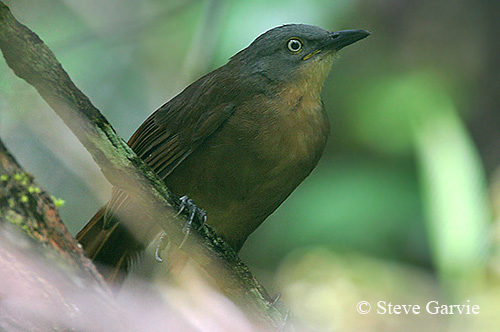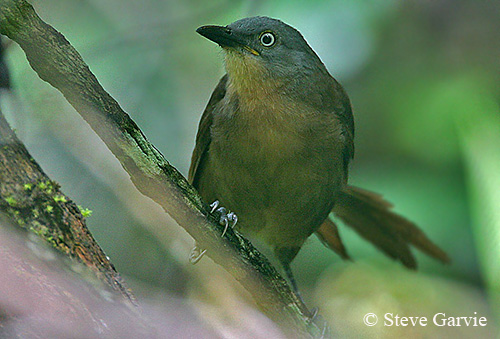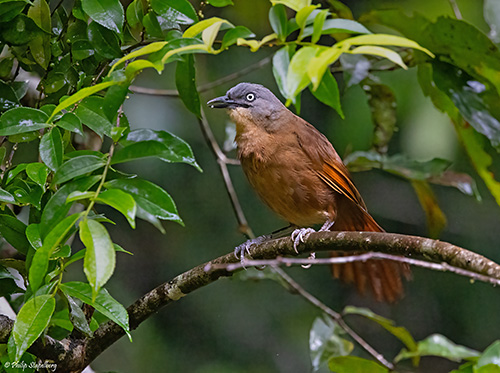
PROTECTION / THREATS / STATUS:
The Ashy-headed Laughingthrush is restricted to the lowland rainforest and the adjacent hills in the wet zone.
It is threatened by heavy clearance of forests, especially in the wet zone, caused by logging, fuelwood collection, agriculture expansion, plantations, mining, fire and human settlements. The species is also disturbed by recreational activities.
The Ashy-headed Laughingthrush is legally protected in Sri Lanka, and it occurs in several national parks and reserves. It is quite common at prime sites like Kitulgala and Sinharaja.
The population is roughly estimated at 3,500/15,000 individuals. It is suspected to be declining due to habitat degradation.
The Ashy-headed Laughingthrush is currently listed as Vulnerable.
Fr: Garrulaxe à tête cendrée
Ang: Ashy-headed Laughingthrush
All: Graustirnhäherling
Esp: Charlatán Cabecigrís
Ita: Garrulo sghignazzante testacenere
Nd: Grijskoplijstergaai
Sd: ceylonfnittertrast
Photographers:
Steve Garvie
RAINBIRDER Photo galleries
Philip Stapelberg
GALLERY
Text by Nicole Bouglouan
Sources:
HANDBOOK OF THE BIRDS OF THE WORLD Vol 12 by Josep del Hoyo-Andrew Elliott-David Christie - Lynx Edicions - ISBN: 8496553423
Wikipedia, the free encyclopaedia
Ashy-headed Laughingthrush
Argya cinereifrons
Passeriformes Order – Leiothrichidae Family
INTRODUCTION:
The Ashy-headed Laughingthrush is a resident breeding species endemic to Sri Lanka.
It usually frequents the deep forests of the wet zone and the adjacent mountains. It feeds on insects and small invertebrates, fruit, and seeds.
They live in noisy flocks of mixed-species, foraging on or near the ground and in fallen tree trunks.
This species nests in an untidy structure made of twigs and leaves, with a neat cup inside. It is placed in bush or fork in small tree, up to 5 metres above the ground. They are known to breed cooperatively.
The Ashy-headed Laughingthrush is threatened by habitat loss, especially in the wet zone, involving degradation and fragmentation of the forests. The population is suspected to be declining, and the species is currently listed as Vulnerable.
DESCRIPTION OF THE BIRD:
Biometrics:
Length: 24-25 cm
Weight: 70 g
The Ashy-headed Laughingthrush has rufous-brown upperparts and deep buff underparts.
On the upperparts, the upperwing and the long, rounded, floppy tail are dull rufous-brown, but the wings show paler brown fringes.
On the underparts, chin and mid-throat are pale buff to whitish, becoming warm buff on the lower throat. The breast is slightly washed buff. The mid-belly is paler.

On the dull grey head, lores, crown and neck sides are bluish-grey, becoming somewhat darker on the nape. The ear-coverts are slightly paler than the crown.
The bill is black, with sometimes paler lower mandible.
The eyes are white but they may show greyish, yellowish or reddish tinge. The eyering is dark.
Legs and feet are dark bluish-grey.
Male and female are similar.
The description of the young bird is made from pictures, but the colour of both eyering and gape is not well defined and seems to be different depending on the season. But generally, the young birds have dark eyes.
In February, the juvenile has less extensive grey on the crown, and its plumage is warmer overall. The eyes are dark with yellow eyering. The legs are dull greyish-flesh. The thick gape is orange-yellow.
In November, the young bird has more restricted orange-yellow gape, but the eye is still dark and the eyering is yellow. The plumage is similar to adults.
RANGE:
The Ashy-headed Laughingthrush is endemic to Sri Lanka and occurs mainly in SC and SW of the island where it is found in lowland and mountain forests.
HABITAT:
The Ashy-headed Laughingthrush is usually rarely seen away from the deep jungle and dense bamboo thickets in the wet zone.
It frequents the rainforest and the adjacent mountains, and can be seen up to 1,200-1,500 metres of elevation. It remains mainly within the forest and away from the forest edge.

CALLS AND SONGS: SOUNDS BY XENO-CANTO
The Ashy-headed Laughingthrush is a noisy bird, and its presence is often revealed by the typical laughing calls of the species. It lives in flocks, and we can constantly hear babbling, squeaking and chattering.
The high-pitched squeaky calls are described as harsh “chrerr”, “chraaaar” or “cheererrrr” often interspersed with sharper “chit” or high-pitched “pieu pieu”.
Some calls resemble the snorting of a horse. It is a very low, loose, snuffling “bur’r’r’r” combined with several other sounds.
BEHAVIOUR IN THE WILD:
The Ashy-headed Laughingthrush feeds mainly on insects and small invertebrates such as grubs, small snails and caterpillars. Insect diet includes bugs (Hemiptera), beetles (Coleoptera), moths (Lepidopetra) and grasshoppers (Orthoptera). The species is also known for eating seeds and berries.
The chicks are primarily fed on insects.
It usually feeds in mixed-flock species of 4-20 individuals. They feed on or near the ground among the leaf litter or in the low vegetation. Fallen mossy tree trunks are also explored.
They often feed by gleaning from the foliage, but they also adopt acrobatic poses to reach the food.
The noisy flocks are often moving while calling continuously.
Some courtship displays have been observed. The displays include mutual preening, tail fanning and wing spreading, while both mates are perched on tree branch.
Cooperative breeding seems to be usual, with often more than two birds attending a nest or perching near the site. They also help to feed the chicks.
The nest is a large mass of twigs and leaves, built up to 5 metres above the ground in the fork of a small tree or in bush.
The Ashy-headed Laughingthrush is resident breeder in Sri Lanka.
The flight is weak, due to the short, rounded wings. It only flies over short distances between the foraging areas.

REPRODUCTION OF THIS SPECIES:
The breeding season probably occurs almost all year round.
The Ashy-headed Laughingthrush is a partly social breeder, and several individuals can be seen near and around a single nest.
From an observation in December 2003 and January 2004, some behaviour has been described.
The nest was a large mass of twigs and leaves on the outer part of the structure. The cup inside the nest was 109 x 97 mm wide and 72 mm deep. It was made of fine rootlets and vines (Lygodium species). This structure was placed in a liana (Calamus zeylonicus) climbing about 20 metres into the canopy. The nest itself was built about 5,3 metres above the ground.
On the morning of 27 December 2003, the nest was empty. But on the morning of 28 December, three turquoise-blue eggs were in the nest, suggesting that more than one female was responsible, knowing that there is a 24-hour gap between the laying of each egg.
The incubation lasts 14-15 days in this species. It was carried out by at least two adults. Change-overs occurred frequently in both early morning and late evening, but during most of the day, only every 60-90 minutes.
The birds of the groups remained within an area of 150-200 metres diameter, which is much closer than usual.
Hatching occurred on 11 January 2004 and more frequent change-overs were observed with three birds coming to the nest. All group members took part in chick-feeding with insects, caterpillars, moths and grasshoppers.
No information on the nesting period.
The nests of the Ashy-headed Laughingthrush are sometimes predated by the Sri Lanka Blue Magpie.
